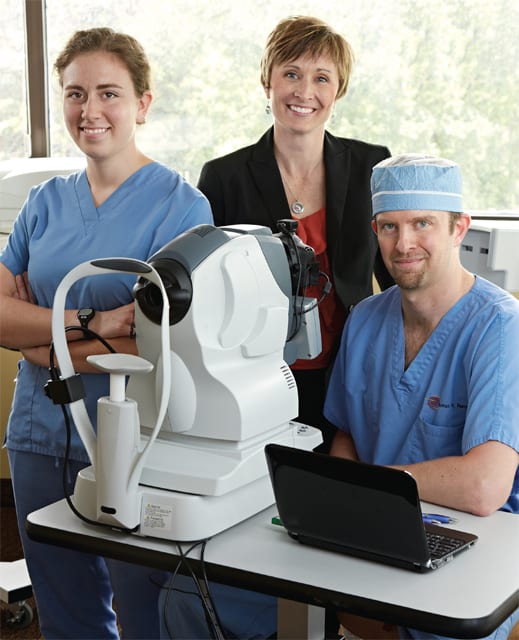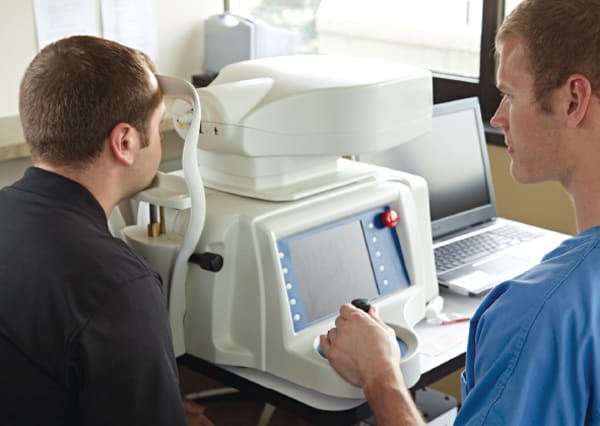
Left to right, Anne Miller, optometric assistant; Jill Halvorson, MBA, COA, ABO, director of clinical operations; Sherman W. Reeves, MD, MPH
As a group ophthalmology practice grows from small to mid-sized, its staff may be tempted to continue following the same workflow and scheduling habits. However, as a practice grows from three, to 10, to nearly 30 providers with multiple locations and a variety of subspecialties, the complexity of the organization forces an internal discussion to evaluate current workflows, provider schedules, and patient satisfaction levels to determine all are in line with the mission and vision of the practice. When adding another complicating factor, like going live on Electronic Health Records (EHR), old ways of thinking are challenged to the point where a decision needs to be made: either embark on a deep cultural transformation, or risk faltering and falling into organizational mediocrity with unhappy employees, unhappy patients, and ultimately, unhappy providers.
At Minnesota Eye Consultants, our practice has experienced growth and a recent EHR go-live. Other challenges associated with rapid practice growth include lack of employee engagement, inconsistency in provider workflow requests and schedules, disorganized training strategies and poor communication.

Jason Klaassen, optometric assistant, displays his expertise with the equipment at Minnesota Eye Consultants.
While Minnesota Eye Consultants does amazingly well and continues to produce exemplary results, we continue to work towards accomplishing the following goals: increasing efficiencies, enhancing employee job satisfaction, improving patient wait times, and maintaining our excellent quality of care in all aspects of the patient encounter. This article details our explorations of new ideas in workflows and new possibilities in collaborative provider schedules.
Define Roles
Currently, we hire for two clinical work-up roles in our five clinic locations; an ophthalmic technician who works with the ophthalmologists and an optometric assistant who works with the optometrists. The ophthalmic technicians are expected to know the clinical preferences for all eight, soon to be nine, subspecialty trained surgeons. The optometric assistant’s role is just as complex with 12 individual optometrists, each with their own preferences for clinical work up. Technicians and assistants are expected to be fast, yet accurate, and excellent at operating all 25 pieces of ancillary testing equipment. They must be able to work long hours at any location. Also, because there is a nationwide refracting technician shortage, having a refracting technician doing visual fields tests and pre-loading means we are not using all the technicians to the peak of their clinical ability.
In order to accomplish the aforementioned goals, we hope to model the roles within our clinics by specialty, similar to how the providers have specialized in different sections of the eye. An ideal structure would include experts in the following areas:
■ Chart pre-loaders: Staffers responsible for chart pre-loading should enter data into EHR from paper charts or from paperwork submitted by the patient either in person, by mail, or via a patient portal.
■ Facilitators: Think of facilitators as “mission control.” They should understand the overall flow of the clinic from check-in to check-out and keep everything running smoothly by handing out charts to appropriate team members, communicating with clinical teams and addressing patient questions.
■ Visual fields: Visual fields testers should be experts at performing both Goldmann and Humphrey visual fields tests. Patients are scheduled 20 minutes apart on each machine. This role also includes prep at least two days prior to appointment.
■ A-Scans, B-Scans, and IOL calculations: Patient scans are scheduled every 15 to 20 minutes. Technicians must be able to determine if scans are reliable and if calculations are accurate, while communicating closely with physicians about abnormalities.
■ Testing technicians: Techs in testing roles must be able to work in testing labs efficiently, and maintain expert operating skills of remaining ancillary equipment.
■ Retinoscopy and refracting technicians: These technicians must check visual acuities, neutralize glasses, perform retinoscopy (or auto-refraction), use their expertise to acquire the best-corrected visual acuity and, finally, to perform a brightness acuity test.
■ History technicians: Depending on whether the patient has already had a refraction, this technician will test vision and IOP; take medical, social and ocular history; update medications; check angles and dilate as appropriate. This role would also perform pupil testing, basic muscle evaluation, and confrontational visual fields.
Such specialization allows patients to experience an expert at each component of the exam. It also allows employees to have a pathway for growth and cross-training within an organization. Workflow specialization requires careful patient screening (to determine if a refraction is necessary) and careful questioning of new patients to determine any other required testing.
Consider these details and scheduling appointments on provider schedules appropriately. Here is a checklist to consider:
■ Long exam with refraction (can also be labeled as cataract evaluation, corneal evaluation, routine annual eye exam)■ Long exam without refraction
■ Medium exam with refraction
■ Medium exam without refraction (medium appointments are used only when dilating for testing and applicable in most cases to a glaucoma specialist clinic)
■ Postoperative with refraction
■ Postoperative without refraction
■ One-day postoperative
■ Brief exam
Scheduling
Decide what testing is necessary and if the patient prefers one long day of tests or multiple shorter days when scheduling the appointment. When patients have that choice, they tend to be more satisfied. The testing labs, A-scan and B-scan room, and visual fields tests rooms each need their own schedules with technicians. The facilitator ensures the patient moves from technician to technician with minimal wait time, and each team member is required to provide clear communication to the patient about what is expected next.
So, how does this all come together and how is the mix of patients determined to schedule per hour? Currently, our surgeons are provided four refracting technicians per day to see six or seven patients per hour. If each of these refracting technicians were able to meet the ASOA average benchmark for a refraction (including auto-refract or retinoscopy, lensometer, visual acuity at distance, with pinhole and at near, and distance and near refraction) of eight or nine minutes, they should each perform five or six refractions per hour, for a total of 20 to 24 refractions per hour.

Kimi Bragdon, COT, ophthalmic technician, provides care at Minnesota Eye Consultants.
Since it is unlikely a provider could see 20 to 24 patients in an hour, we have essentially decreased our need for refracting techs to one per surgeon (five to six refractions per hour). The surgeon would then be assigned two history techs (who don’t need to know how to refract) and then share resources with the rest of the clinic for testing (visual fields, testing lab, and scans). One history technician’s goal would be the ASOA average benchmark of 10 to 12 minutes to complete the remaining portion of the exam, working in tangent with the refracting technician. The other history technician would do brief exams, one-day post-ops and any medium or long exams that do not require refraction. Providers can have a potential schedule of five exams requiring a refraction and five exams not requiring a refraction for a total of 10 patients per hour with three allocated technicians and the shared resources for testing.
A Delicate Balance
Even the most ideal plans for transforming workflows to achieve goals like increasing efficiencies, enhancing employee job satisfaction, improving patient wait times, and maintaining excellent quality is a delicate balance. It is almost impossible to implement without a supportive culture built on a foundation of mutual respect and trust, an openness to collaboration, willingness to communicate and the courage to embrace change.
Practice owners, managers and each employee will need to individually and retrospectively evaluate themselves and ask: What is my contribution? Am I a roadblock in the way of achieving the practice goals? How can I change to become part of the solution? Answering these questions honestly can foster honest communication and guide the practice through this period of transformation. OP

|
Jill Halvorson, MBA, COA, ABO |








